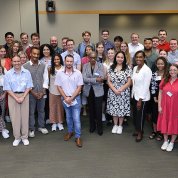NIBIB Welcomes Congressional Staff to Showcase Innovative Medical Technology

Photo: Chia-Chi Charlie Chang
Fifty congressional staff visited NIH to learn about cutting-edge technologies supported by the National Institute of Biomedical Imaging and Bioengineering (NIBIB) that could become transformative medical applications in the future.
NIBIB Director Dr. Bruce Tromberg kicked off the event by highlighting the focus areas of NIBIB’s science and technology research. He also described the unique partnerships needed to develop technologies to improve health.
Congressional staff then participated in five hands-on demonstrations given by NIBIB-funded grantees and intramural researchers.

Photo: Chia-Chi Charlie Chang
A collaborative team from Duke University, Harvard Medical School and Brigham and Women’s Hospital presented a new ultrasound method that could make surgery less invasive and safer. The technique combines a novel bioink with focused ultrasound to print 3D structures through solid tissues. Dr. Junjie Yao, who led the research team, described how this technique could be used to repair heart tissue without having to make an incision.
Another demonstration by the co-founders of Xander Medical (Alexandra Bisaccia and her business partner and brother Jackson Bisaccia) focused on their innovative titanium interlock screw that could be used to improve orthopedic surgery. Their novel design prevents stripping or breaking of surgical screws, a common problem in bone repair, which requires additional surgeries.

Photo: Chia-Chi Charlie Chang
Another demonstration was given by senior investigator Dr. Manu Platt who established and directs NIBIB’s Section on Mechanics and Tissue Remodeling Integrating Computational and Experimental Systems (MATRICES) laboratory.
Platt said his lab focuses on understanding how healthy tissues transition to diseased states and how to stop that progression. The research has focused on using protein enzymes as functional biomarkers to develop new diagnostics and therapeutics for sickle cell disease, cancer metastasis and other conditions.
He described a low-cost screening method that can be used for early detection of diseases such as sickle cell that are prevalent in low-income countries.
Photo: Chia-Chi Charlie Chang
Congressional staffers also visited the laboratory of Dr. Kaitlyn Sadtler, investigator in NIBIB’s Section on Immunoengineering, which she called the intersection of immunology and regenerative medicine. Her lab evaluates how our bodies respond to traumatic injuries and how biomaterials can be used to engineer better therapeutics for tissue regeneration.
The final laboratory tour and demonstration was held in Dr. Alexander Cartagena-Rivera’s lab. He is an investigator in NIBIB’s section on mechanobiology, where he develops atomic force microscopy (AFM) technologies. Cartagena-Rivera explained his lab is using AFM imaging to better understand two conditions: hearing loss and cancer. The scans enable researchers to study the structures and the biomechanical properties of tissues from people with these conditions. He said combining their tissue profiling strategy with machine learning analyses could help clinicians make diagnoses with greater precision.
The event came at the invitation of the American Institute for Medical and Biological Engineering (AIMBE), an advocacy group that brings together academia, industry, government and scientific societies to advance innovative, high-impact biomedical technologies. The showcase provided an opportunity for congressional staff to better understand how NIH research today is translated into the medical interventions of the future to solve complex health care problems.




